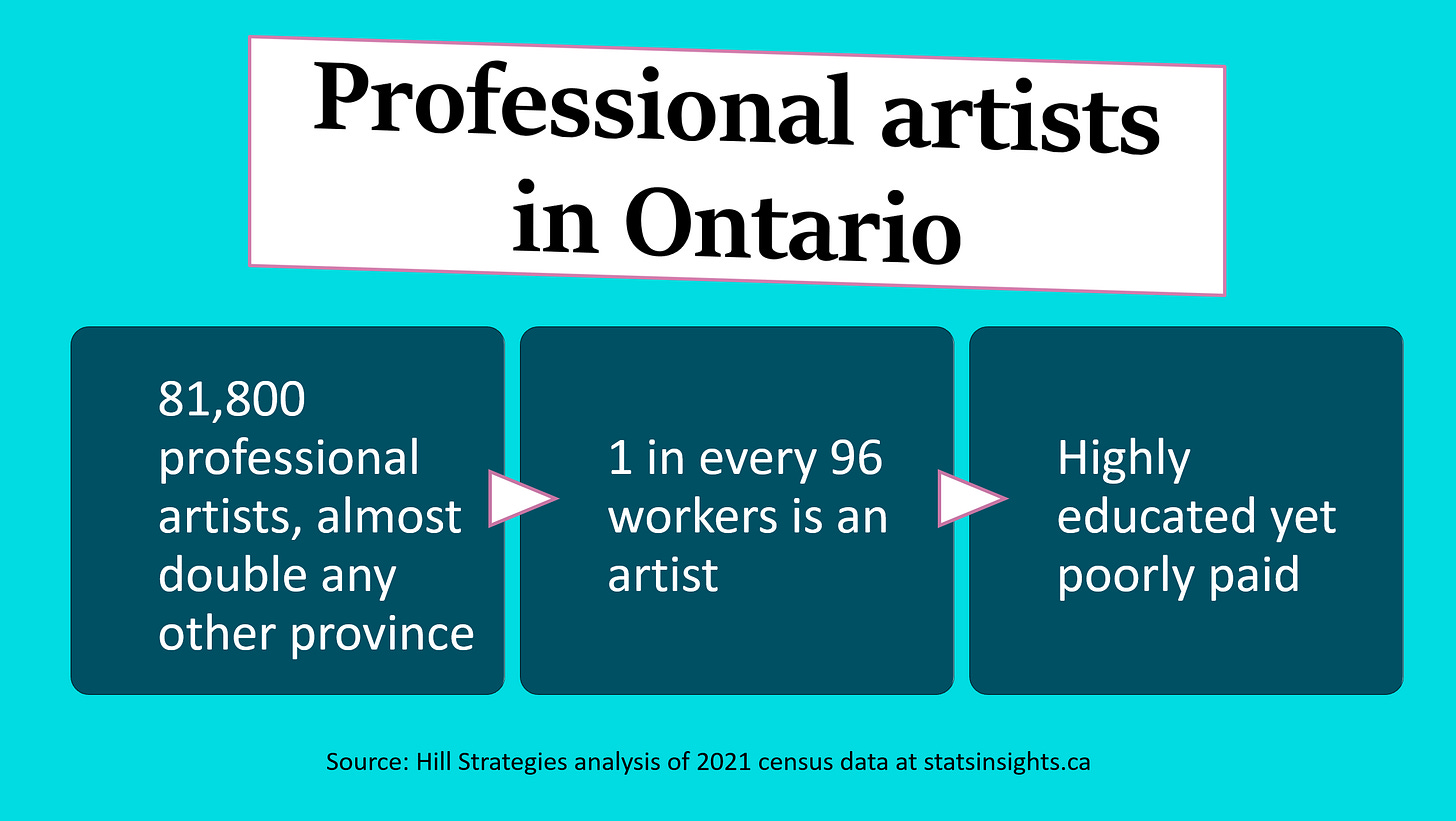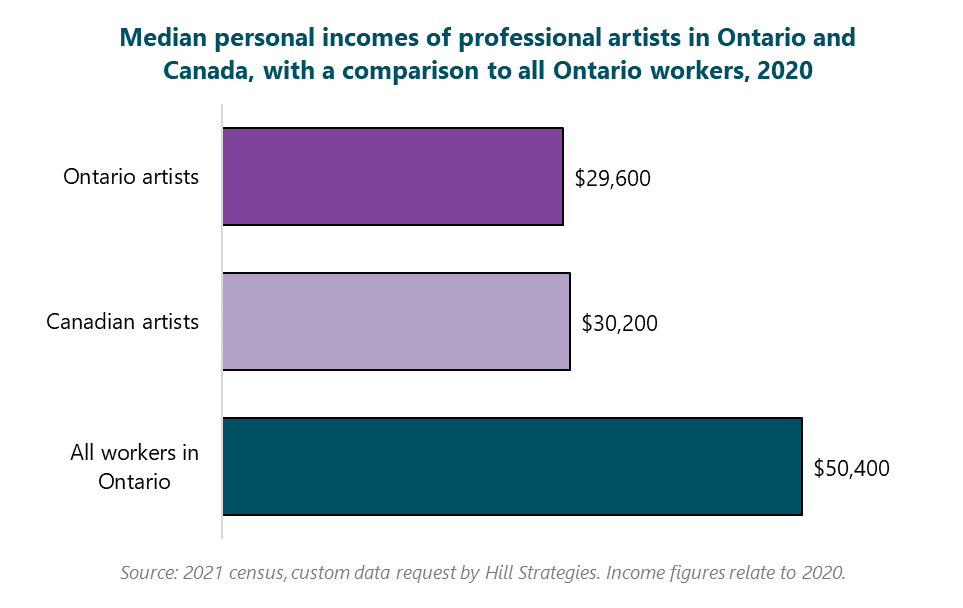Artists in Ontario in 2021
Over 80,000 professional artists, with high education levels but very low incomes
Using custom data that Hill Strategies requested from Statistics Canada’s 2021 long-form census, this article examines the demographics, employment characteristics, and incomes of artists in Ontario, as well as summary information about workers in arts leadership occupations and all occupations in the arts, culture, and heritage (a category that includes artists and arts leaders).
This article is made possible with the support of the Ontario Arts Council.
Hill Strategies Research retained full editorial control of the content.
This is a sponsored post using custom data that I requested from the 2021 census. If you are not yet a sponsor but are interested in this type of information for your jurisdiction, please let me know. Or simply subscribe at the sponsor level ($750 including taxes) here:
Methods
The analysis relates to professional workers, but with a very specific concept of professional. The census data on occupations include people who worked more hours as an artist than at any other occupation between May 1 and 8, 2021, plus people who were not in the labour force at that time but had worked more as an artist than at another occupation between January of 2020 and May of 2021. Part-time artists who spent more time at another occupation in May of 2021 would be classified in the other occupation. (The same would be true of workers in arts leadership occupations and all cultural occupations.)
The occupational perspective counts people who work across the economy, as long as they are classified into one of 10 artist occupation groups, 5 arts leadership occupation groups, or 52 cultural occupation groups. Details about the occupation groups included in each of the categories is available in a recent article, which also outlined the methods behind choosing the 52 cultural occupation groups. Another article highlighted some strengths and limitations of the census for counting artists and cultural workers.
To ensure confidentiality and data reliability, no estimates of fewer than 40 people are presented in this article.
The challenging context of the pandemic in the spring of 2021 is important to keep in mind when interpreting census data on artists, which were collected in May of 2021. Income data from the census relate to the 2020 calendar year.
Canada-wide data
Across Canada, there are 202,900 professional artists, representing 1.0% of the Canadian labour force. Examined differently, this means that 1 in every 102 Canadian workers is an artist. (A full article on Canadian artists is available here.)
A similar analysis examines workers in arts leadership occupations in Canada, There are more than 56,000 Canadian workers in five occupation groups, including producers, directors, choreographers, conductors, composers, curators, conservators, and arts and heritage managers. Two of the arts leadership occupations (conductors / composers and producers / directors / choreographers) are also included as artists. As such, the number of arts leadership workers should not be added to the number of artists.
The broadest analysis relates to the 914,000 workers in arts, culture, and heritage occupations, representing 4.4% of all Canadian workers. The 52 occupation groups in this category include the 10 artist occupation groups as well as the 5 arts leadership occupation groups, other cultural occupations (e.g., graphic designers, print operators, editors, translators, architects, and professionals in fundraising, advertising, marketing, and public relations), and heritage occupations (e.g., librarians, curators, and archivists).
Over 80,000 professional artists in Ontario, by far the most of any province
With 81,800 professional artists, Ontario accounts for 40% of all Canadian artists, almost double the number of any other province.
The 81,800 artists in Ontario represent 1.0% of the province’s overall labour force, second only to British Columbia (1.4%) among the provinces. The relatively high concentration of artists in Ontario helps to define the national average (also 1.0%). In Ontario, 1 in every 96 workers is an artist.
Professional artists had very low incomes in 2020
This article focuses on median incomes, which are believed to provide a better indication of the typical situation of professional artists than the average (i.e., the “mean”), which is more strongly affected by a few individuals with very high incomes. It should be kept in mind that the income statistics from the 2021 census relate to the 2020 calendar year, which included many pandemic related lockdowns and significant slowdowns in artistic activity.
Three measurements of artists’ incomes are provided: median employment income, median personal income, and median household income. Employment income shows the work-related earnings of artists; personal income includes all sources of income (including pandemic supports); and household income provides a measure of the family situation of artists.
The income statistics indicate that Ontario’s artists are at a significant disadvantage, with personal incomes 41% less than other workers. That disadvantage carries over into household incomes that are 23% lower than other workers.
The median employment income of Ontario artists was just $11,200 in 2020, which is about one-quarter of the median employment income of all Ontario workers ($42,400). The median employment income of artists in the province was essentially equal to the median of all Canadian artists ($11,700).
The median personal income of artists (from all sources) was $29,600 in 2020, 41% below that of all Ontario workers ($50,400). Once again, the level in Ontario helps to define the median of all Canadian artists, which is a very similar ($30,200). The graph below shows the median personal incomes of all artists in Ontario, all Canadian artists, and all Ontario workers.
In 2020, the median household income of artists was $98,000, 23% lower than that of all workers in Ontario ($127,000) but slightly higher than the median of all Canadian artists ($93,000).
Diverse demographics, high education levels, and a very high self-employment rate
Among Ontario artists:
53% are women (including some transgender and non-binary people), much higher than the proportion of all Ontario workers (48%) but similar to that of all Canadian artists (54%).
30% have a child at home, lower than the percentage of all Ontario workers (42%) but similar to that of all Canadian artists (31%).
23% are members of racialized groups, below the percentage of all Ontario workers (34%) but higher than that of all Canadian artists (19%).
25% are immigrants to Canada, lower than the percentage of all Ontario workers (33%) but higher than that of all Canadian artists (21%).
2.5% are Indigenous, equal to the proportion of all Ontario workers (2.6%) but slightly below that of all Canadian artists (3.7%).
5% are French speakers (i.e., official language minority), equal to the percentage of all Ontario workers (5%) but much lower than official language minority speakers’ proportion of all Canadian artists (11%).
5% are Jewish (by religion, ethnicity, or both), the highest proportion in Canada, higher than the percentages of all Ontario workers (2%) and all Canadian artists (3%).
48% have a bachelor’s degree or higher, well above the percentage of all Ontario workers (36%) and slightly above that of all Canadian artists (45%).
28% are 55 years of age or older, higher than the proportion of all Ontario workers (24%) but equal to that of all Canadian artists (28%).
69% are self-employed, nearly five times higher than the percentage of all Ontario workers (15%) but similar to that of all Canadian artists (68%).
78% reside in areas with populations over 100,000, the highest proportion among the provinces.
The City of Toronto, on its own, accounts for 39% of all artists in Ontario. There are as many artists in the City of Toronto as in all other areas in Ontario with populations over 100,000.
10% reside in rural areas, 7% reside in areas with populations under 30,000 (but which are not considered rural), and another 5% reside in areas with populations between 30,000 and 100,000. Combined, these smaller population areas account for 22% of Ontario’s artists.
For the first time, the 2021 census collected information on transgender and non-binary residents. In Ontario, there are about 300 transgender and 680 non-binary artists. Combined, trans and non-binary artists represent 1.2% of all Ontario artists, equal to the national average. (More information about the strengths and limitations of the statistics on gender identity is available here.)
Ontario artists by occupation and industry
There is a wide range of types of professional artists in Ontario:
Musicians: 15,100 (18%)
Producers, directors, choreographers & related occupations: 14,700 (18%)
Writers: 12,800 (16%)
Photographers: 8,200 (10%)
Painters, sculptors & other visual artists: 7,900 (10%)
Actors, comedians & circus performers: 7,600 (9%)
Artisans & craftspeople: 7,300 (9%)
Dancers: 4,200 (5%)
Other performers: 2,400 (3%)
Conductors, composers & arrangers: 1,700 (2%)
For Ontario’s artists, the largest industry sector is arts, entertainment, and recreation, which employs almost one-third of artists (31%). Within this sector, the largest number of artists work in the “independent artists, writers, and performers” group (21% of Ontario artists), followed by those who work directly in performing arts companies (9%).
The next-largest broad sectors are information and cultural industries (where 19% of Ontario artists are employed) and educational services (18%). Other artists work across the economy: all other industries (excluding the three largest ones) employ 32% of artists.
Ontario’s arts leaders
23,000 Ontarians work in five occupation groups that are classified as arts leaders, with the broad grouping of producers, directors, and choreographers accounting for nearly two-thirds of them:
Producers, directors, choreographers & related occupations: 14,700 (64% of the arts leaders in the province)
Managers in publishing, motion pictures, broadcasting & performing arts: 3,900 (17%)
Library, archive, museum & art gallery managers: 1,800 (8%)
Conductors, composers & arrangers: 1,700 (7%)
Conservators & curators: 960 (4%)
Ontario accounts for 41% of Canada’s arts leaders, slightly higher than the province’s share of all workers (38%).
Summary information about workers in arts, culture, and heritage occupations in Ontario
There are 370,000 workers in arts, culture, and heritage occupations in Ontario, representing 4.7% of the province’s overall labour force, one of the highest proportions in the country and above the national average of 4.4%. One in every 21 workers in the province has a cultural occupation.
The 370,000 workers in arts, culture, and heritage occupations account for 40% of all such workers in Canada, slightly higher than the province’s share of the overall labour force (38%).
In 2020, a typical cultural worker in Ontario had:
Employment income of $39,200, 8% less than all Ontario workers ($42,400)
Total personal income of $46,400, 8% less than all workers in the province ($50,400)
Household income of $118,000, 7% less than all workers ($127,000)






